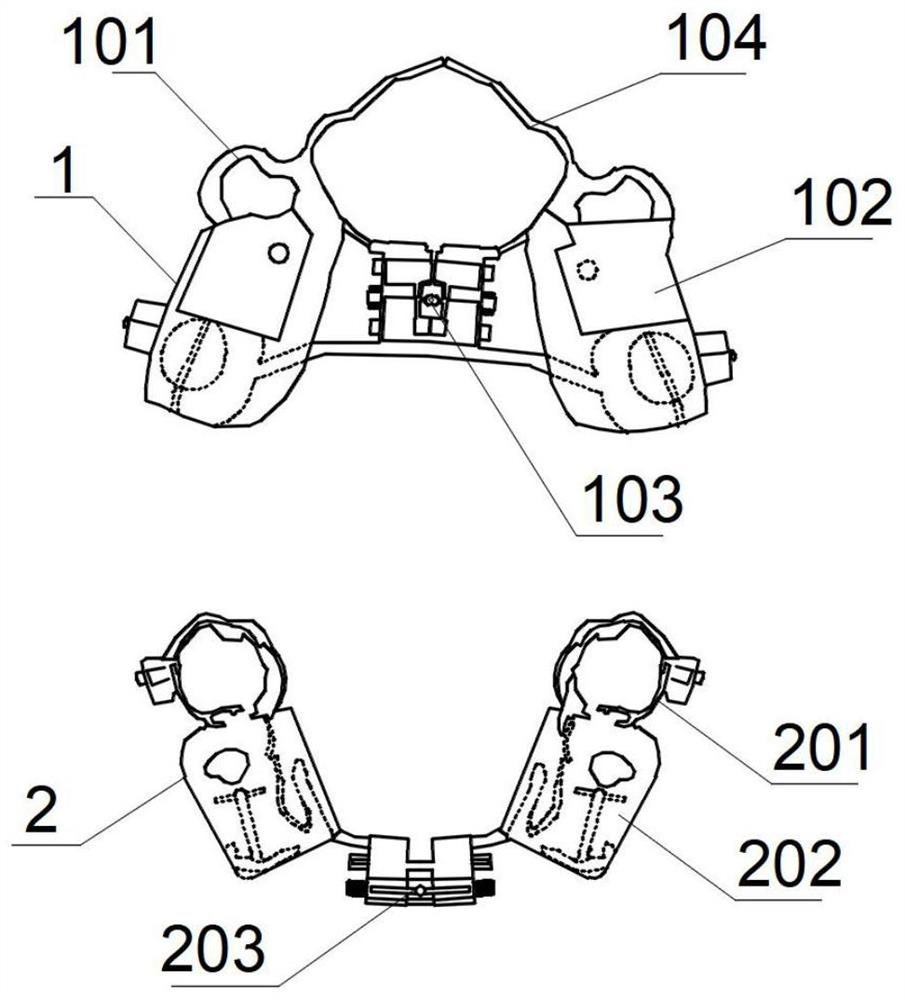Fixed type low anterior tooth Tin-block appliance and working principle thereof
An appliance and fixed technology, applied in dentistry, orthodontics, prosthetics, etc., can solve the problem that the upper and lower anterior teeth cannot be aligned at the same time, the labial tilt compensation of the mandibular anterior teeth, and the undesigned upper and lower anterior teeth, etc. To achieve the effect of orthodontic treatment, improve dentition crowding, and avoid side effects
- Summary
- Abstract
- Description
- Claims
- Application Information
AI Technical Summary
Problems solved by technology
Method used
Image
Examples
Embodiment 1
[0043] Application of a fixed twin-block appliance for depressing anterior teeth in the correction of misaligned teeth:
[0044] A fixed twin-block appliance for depressing anterior teeth, consisting of a maxillary appliance 1 and a mandibular appliance 2. The upper appliance 1 consists of a casting-type belt ring 101 of the upper jaw of the bilateral posterior teeth through the central maxillary rapid expansion arch connected with appliance 203, the bilateral posterior occlusal surfaces are composed of upper occlusal pads 202, and the lingual side of the anterior teeth is provided with a separate lingual arch 104, and the mandibular appliance 2 is looped through the center by the lower casting belt 201 of the bilateral posterior teeth. The lower rapid arch expander 203 is connected, the bilateral bicuspid occlusal surface is composed of the mandibular occlusal pad 202, and the No. 6 tooth position of the mandibular appliance is a cast belt ring with a buccal tube to match Mul...
Embodiment 2
[0047]Based on Example 1, children who are in the replacement dentition period usually choose the first permanent molars on the upper and lower sides of the upper and lower jaws because of the retention teeth, and the first and second deciduous molars on the upper and lower sides of the jaws are the retention teeth. At this time, the first permanent molars The root of the tooth has been basically developed, and the first and second deciduous molars have not yet started to be replaced. A fixed twin-block appliance is used to depress the anterior teeth. The use of multi-purpose bow 3 can provide better retention conditions, and at the same time, it has less side effects on the remaining teeth in the mouth, and the force is transmitted to the alveolar bone through the retention teeth, thereby remodeling.
Embodiment 3
[0049] Based on Example 1-2, a large number of gaps are provided after the upper and lower jaws are expanded, which provides a large amount of gaps for the eruption of inherited permanent teeth, and also provides a solution for adjusting the current problems such as uneven dentition and deep overbite. Gaps are more conducive to tooth replacement; malocclusions are mostly abnormalities in the three-dimensional direction of the upper and lower jaws, teeth, and soft tissues. The upper and lower jaws are provided with gaps after the bow is expanded using the present invention, and the gaps are used to depress the upper and lower front teeth to solve the vertical problem. The upper abnormality is more conducive to the correction of sagittal misalignment. At the same time, patients with crowded upper and lower dental arches usually have abnormal tongue positions. After the upper and lower jaws are expanded, the width of the dental arch increases, providing sufficient space for the ton...
PUM
 Login to View More
Login to View More Abstract
Description
Claims
Application Information
 Login to View More
Login to View More - R&D
- Intellectual Property
- Life Sciences
- Materials
- Tech Scout
- Unparalleled Data Quality
- Higher Quality Content
- 60% Fewer Hallucinations
Browse by: Latest US Patents, China's latest patents, Technical Efficacy Thesaurus, Application Domain, Technology Topic, Popular Technical Reports.
© 2025 PatSnap. All rights reserved.Legal|Privacy policy|Modern Slavery Act Transparency Statement|Sitemap|About US| Contact US: help@patsnap.com


